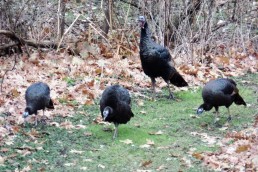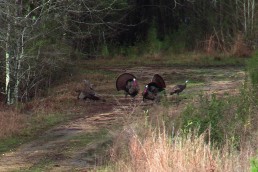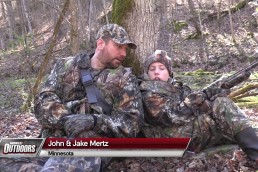Turkey Vision and the Hunter
SHARE THIS POST
The spring turkey hunting season is an anticipated event for many hunters. Unless these hunters were participating in outings for small game during the winter months, it has been a long wait to get back into the woods since the fall hunting season. Months of cabin fever has put cobwebs in the brains of hunters. Only the fresh scent of the woods will provide the cure.
In the weeks leading up to the first outing, turkey hunters have dusted off their turkey calls and practiced the art of turkey calling. All turkey hunters, both seasoned and amateurs, have high hopes of luring a turkey to within shooting range when the season opens. Effective turkey calling certainly is an important part of the hunting equation, but there is more to the complex puzzle of bagging a turkey. Unfortunately for the hunter, the turkey has a keen sense, which doesn’t make this an easy task.
It’s a well-known fact that turkey have very good eyesight. Eyesight is the strongest sense of the turkey. It is the first line of defense against any perceived predators that have entered or inhabit their realm. When the turkey sees a potential threat within the woods, they will always go in the opposite direction. The best turkey caller in the county won’t get those visually acute birds to change their minds. Believe me, the turkey sees everything in the woods. For the turkey hunter to be successful, the hunter must understand the vision of a turkey.
The best eyes in the woods
First and foremost, turkey possess exceptional eyesight. One of my hunting buddies proudly brags about how good his eyesight is because his eye doctor complimented him by saying that he has the eyes of a fighter pilot. As notable of a compliment that is, it’s quite unlikely that the good doctor has ever preformed an eye test on a turkey. If a doctor looked closely into the eyes of a turkey, he would probably be surprised to learn that a turkey’s vision is three times better than any human that has been bestowed with perfect vision. With acutely clear vision, the turkey is able to detect the slightest of movements at distances up to 100 yards.
For a turkey hunter to have even the most remote chance of success, that hunter must practice and perfect the art of being completely motionless within the environment of the turkey. If a turkey hunter moves the slightest bit, all bets for success are lost, because the turkey will see the movement.
A flexible neck attached to a bobbing head
With eyes positioned on the side of their head, most birds have a profound advantage of having a 270-degree field of peripheral vision. Compared to humans that possess a peripheral vision field of 180 degrees, that’s pretty darn good. The peripheral vision of a turkey is a lot better than any human. And, the flexible, rotating turkey neck beats out the majority of birds.
Are you enjoying this post?
You can be among the first to get the latest info on where to go, what to use and how to use it!
Most seasoned turkey hunters have noticed that turkeys bob their heads up and down quite often. This may look like a humorous nervous twitch to some, but the turkey is doing this head-bobbing movement to further enhance their vision. As the turkey bobs his head, the eyes are gathering information about depths of field and distances. All that information is being sent to the brain. For the turkey hunter, this means that the turkey is capable of seeing you no matter what the position of its body and your distance to the location of the turkey. Yep, you could say that the turkey literally has measuring tape eyes behind its back.
An eye with advanced color perception
A human eye retina is comprised of four different photoreceptors. There is one rod cell that detects color intensity. Human eyes also have three different types of cone cells that detect color. These three cone cells enable the human eye to perceive primary colors of red, green and blue, and many other different types of colors that are made up of the combined three primary colors. A turkey eye has seven different types of photoreceptors, consisting of one rod cell and six cone cells. With double the amount of cone cells, the turkey is capable of perceiving many more colors—including some colors that humans aren’t able to distinguish. I often wonder what colors they see that we aren’t capable of seeing. The turkey certainly isn’t going to tell us.
Turkey hunters look like light bulbs in the woods
Another profound advantage that the turkey possesses is that its eye is able to perceive ultraviolet light. The UV residue that is present on clothing, including camouflage clothing, will make the turkey hunter extremely visible to the turkey, even if the hunter remains completely motionless. In the eye of the turkey, the turkey hunter will literally glow like a light bulb in the woods. To make matters worse, there are laundry detergents on the grocery store shelves that will further brighten the clothing so it is even more visible to the turkey. Knowing this, the turkey hunter would be prudent to choose laundry detergents that do not brighten clothing. Read the labels on the laundry detergents and shop with that in mind.
Luckily for the advantage of the turkey hunter, the scientific community figured out the dilemma faced by hunters and developed ultra-violet elimination spray. A wise purchase for any turkey hunter, this liquid is sprayed on the camouflage clothing and definitely controls the UV glow.
Make yourself invisible
Understanding the eyesight of a turkey is definitely a big part of the equation for pursuing the turkey and is just as important as being the best turkey caller on the planet. Give the turkey high esteem for having incredible eyesight, and base hunting strategies around this. The successful turkey hunter must be fully camouflaged (that includes face and hands) and mask their UV signature to blend in with the environment.
Minimize all movement
Practice the art of becoming a stone statue. If any movement is made, such as the raising of the shotgun to draw a bead on the turkey, do it in super-slow motion. If the turkey hunter adheres to these guidelines, the hunter will experience many more wise turkeys responding favorably to the turkey call. A fresh meal of turkey will be on the dinner table.
MWO
SHARE THIS POST
Did you enjoy this post?
You can be among the first to get the latest info on where to go, what to use and how to use it!
John Murray
John Murray has a passion for the outdoors. A former professional fly tyer and fishing shop owner for more than a decade, John is a member of the NYS Outdoor Writers Association and is determined to share an acquired lifetime of knowledge to help everyone become proficient hunters and anglers.



